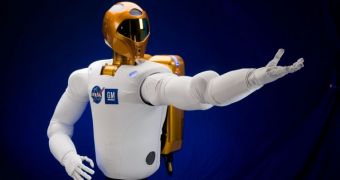Yesterday, February 15, marked a special occasion aboard the International Space Station (ISS). Robonaut 2, the robotic astronaut assistant developed by NASA and General Motors, has been reactivated, and greeted the Expedition 30 Commander, and the world.
After it was turned on, the robot gave a “heartfelt” handshake to NASA astronaut and ISS Commander Dan Burbank. It then saluted the entire planet with the message “Hello, World,” given in American Sign Language.
Robonaut 2 was developed in order to make the lives of ISS astronauts easier. At first, it will only conduct operations inside the station, but plans call for it to aid its human colleagues during extra-vehicular activities (EVA), in the near future.
Great care was taken to ensure that the machine is suited for working alongside humans. It has extremely fine-tuned controls, meaning that it can tell when it exerts too much pressure on an object or biological material. This is why it could shake Burbank’s hand without crushing it.
“For the record, it was a firm handshake. Very nice […] nice job on the programming and all the engineering. Quite an impressive robot,” Burbank told Mission Control, while filming the moment for future reference.
“Today was a major step forward in R2's development. The crew and the robot are working extremely well together and we’re looking forward to all the opportunities that will develop from this collaboration,” Robonaut 2 program manager, Ron Diftler, said, quoted by Space.
He explained that the robot was designed to operate with a high degree of autonomy. At the same time, it is perfectly capable of carrying out complex tasks, or at least help astronauts carry them out. The machine arrived on the ISS in February, 2011.
It was carried to low-Earth orbit aboard the space shuttle Discovery, during the orbiter's final flight. The machine weighs around 150 kilograms (330 pounds), and is about 1.01 meters (3 feet, 4 inches) tall. It was first powered up last August, and has been undergoing rigorous testing ever since.
After researchers conduct a series of trials meant to assess the status of R2's onboard cameras, they will start to run dexterity tests. The latter are meant to verify that the robot can operate switches and other controls aboard the ISS with precision.

 14 DAY TRIAL //
14 DAY TRIAL //